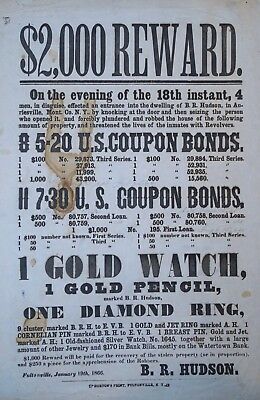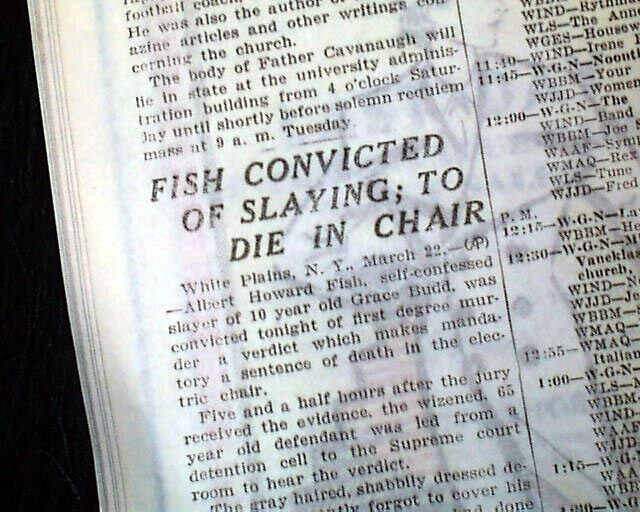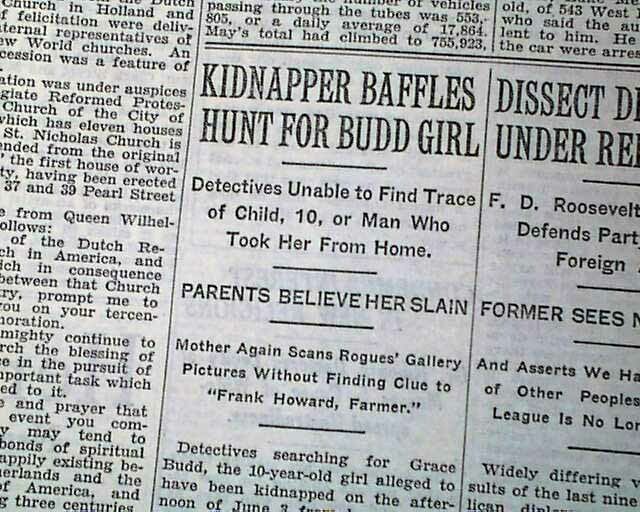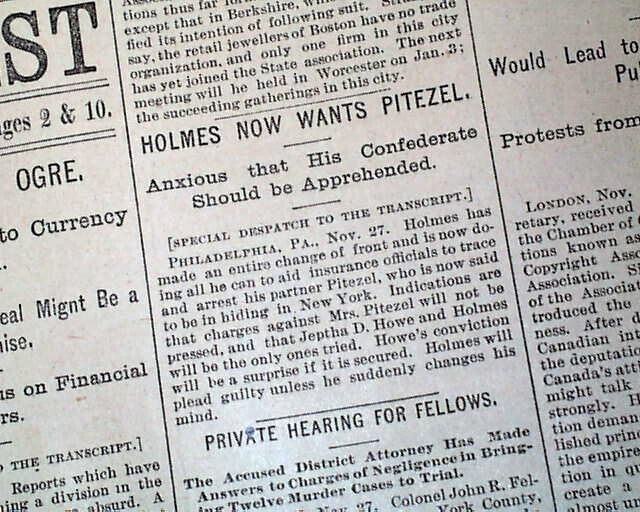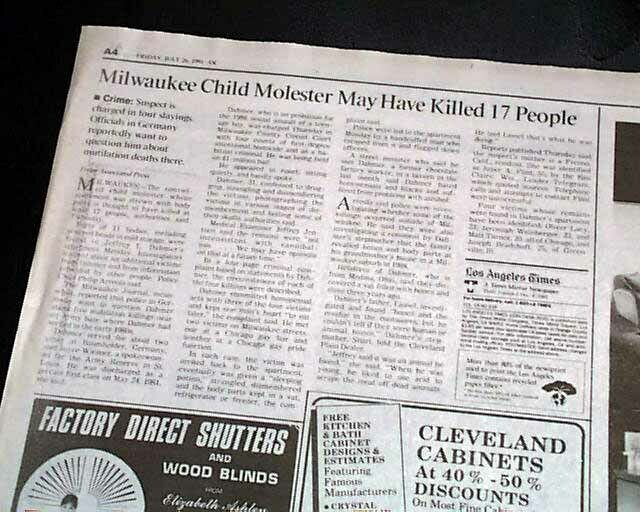-40%
x RARE Broadside - Reward Wanted Poster THEFT - Auriesville NY Fultonville 1866
$ 789.35
- Description
- Size Guide
Description
RARE Original Broadside Poster,000 Reward
4 Men Wanted for Stealing Valuables (listed) at Gunpoint
B.R. Hudson of Auriesville, New York
Printed at Fultonville, NY
1866
FOR OFFER - a rare and nice old broadside. Fresh to the market from a local estate - Never offered on the market before.
All original, vintage, old, antique - guaranteed -
NOT
a reproduction!
"On the evening of the 18th instant, 4 men, in disguise, effected an entrance into the dwelling of B.R. Hudson, in Auriesville, Mont. Co., N.Y., by knocking at the door and then seizing the person who opened it, and focibly plundered and robbed the house of the following amount of property, and threatened the lives of the inmates with Revolvers." [lists U.S. Coupon Bonds, gold watch, pencil, diamond ring, various other piece of jewelry, and bank note bills from the Watertown bank]. Signed at bottom in type by B.R. Hudson. Printed by Horton's Print, Fultonville, N.Y. January 19th, 1866.A few areas of pencil correction to U.S. Bonds. Measures just under 18 x 12 inches. In good to very good condition. Stained on a couple areas, minor margin loss at lower rh corner, edge wear, small archivally repaired tip at top lh corner area. Please see photos.
I
f you collect American history, Americana, 19th century poster / broadside printing, type face / movable type printing, crime, police / criminal, burglary, stolen property, etc. this is a wonderful, unique item for your paper or ephemera collection. Genealogy research information here as well. Combine shipping on multiple purchases. 1762
Auriesville is a hamlet in the northeastern part of the Town of Glen in Montgomery County, New York, United States, along the south bank of the Mohawk River and west of Fort Hunter. It lies about forty miles west of Albany, the state capital. A Jesuit cemetery is located there, as French Jesuits founded a mission village here in the area from 1667 until 1684, when the Mohawk destroyed it. Auries is said to have been the name of the last Mohawk known to have lived there. Settlers named the village after him.
Since the late 19th century, a Catholic tradition developed associating Auriesville as the site of the Mohawk village Ossernenon, where Jesuit missionaries were martyred in 1642 and 1646. The National Shrine of the North American Martyrs was built here in 1930 and has added to its grounds. But, according to Dean R. Snow and other late 20th-century archeologists specializing in Native American history, Ossernenon was located about 9 miles west on a tributary on the south side of the Mohawk River. Archeologists who have excavated there refer to it as the Bauder site.[2] The association of Auriesville with Ossernenon has not been supported by archeological evidence.[3][2]
History
Auriesville, located in Montgomery County, New York, has been said to have developed at the presumed site of the Mohawk village known as Ossernenon. But, according to Dean R. Snow, it was not until the late nineteenth-century that this Catholic tradition developed. It is disproved by archeological evidence discovered by Snow, Donald A. Rumrill, and other 20th-century archeologists who assert that Ossernenon was located about 9 miles west of Auriesville on a tributary south of the Mohawk River. The archeological site associated with the former village of Ossernenon is known as the Bauder site.[3][4][2]
Catholic historians wanted to establish the location of the deaths of three Jesuit Catholics who were martyred in the 1640s by the Mohawk, as well as others held and ritually tortured by the tribe. Ossernenon was also known as the birthplace of Kateri Tekawitha, whose reputation as a pious Catholic Mohawk had grown since the 17th century. (In the 21st century, she was canonized as a saint, with the distinction of being the first Native American of the U.S. so-honored.) Auriesville has been associated with an historic Jesuit mission that operated in Ossernenon from 1667 to 1684, when it was destroyed by the Mohawk.
Archeologists have identified the Mohawk village of Caughnawaga (also spelled Gandawaga), where Tekakwitha lived during her childhood, as a new village site on the north side of the river, founded in 1659. Caughnawaga was settled at what archeologists refer to as the Freeman site; as was their custom, its Mohawk residents took the name with them also when they moved the village to the nearby Fox Farm site. Excavations have supported conclusions of Mohawk settlement here. The sites are both to the west of present-day Fonda, New York.[3] Tekakwitha moved as a young child with relatives to Caughnawaga in the early 1660s after her parents' deaths; she converted to Catholicism at the age of 19 and was baptized Catherine, or Kateri.
She, along with numerous other converted Mohawk, migrated north to the St. Lawrence River area, settling opposite Lachine (later Montreal). They developed a mission village known as Caughnawaga and later spelled as Kahnawake, reflecting Mohawk pronunciation.[3] officially the Jesuit mission here was founded by 1718 for Iroquois and other converts to Catholicism. Most residents were Mohawk. Today Kahnawake is recognized as a Mohawk Indian reserve within the boundaries of Quebec.
Mohawk village of Ossernenon
The Mohawk village of Ossernenon was destroyed in a punitive raid in retribution for the killing of French missionaries ca. 1666, after which its exact locus became uncertain, but which subsequent research put it about nine miles west the current hamlet of Auriesville. The French Jesuit missionaries Saint René Goupil, Saint Isaac Jogues, and Saint Jean de Lalande, were martyred by the Mohawk at Ossernenon: Goupil in 1642 and Jogues and LaLande in 1646. Ossernenon was located south of the Mohawk River, about 9 miles to the west of present-day Auriesville.[3] Taken captive in Canada by Mohawk warriors, Jogues and Goupil were brought as prisoners in 1642 to Ossernenon. They were ritually tortured and then enslaved by the Mohawk. Goupil was killed later in 1642. After several months, Jogues was ransomed by Dutch traders from Fort Orange (Albany), with the aid of Protestant minister Johannes Megapolensis, who had good relations with the Mohawk.[5] Jogues sailed down the Hudson River to return to France by way of New Amsterdam.[6]
In 1644, François-Joseph Bressani was ritually tortured by Mohawk at Ossernenon after being taken captive. Later on, Joseph Poncet also suffered that treatment.[6] Jogues returned to Quebec as a missionary. In late September 1646, he set out for Ossernenon on a peace mission to the Mohawk with Lalande, a young Jesuit lay brother. Jogues was killed on October 18, 1646. Lalande was killed the next day while trying to recover his colleague's body from the village path.[6]
From 1655 to 1658 Father Simon Le Moyne reported traveling a number of times to Ossernenon from Quebec as an ambassador to negotiate peace with the Mohawk. Many Mohawk left Ossernenon, establishing a new village about 1659 which they called Caughnawaga on the north side of the Mohawk River. As noted above, archeologists have correlated references to this with evidence found at what are known as the Freeman and Fox Farm sites.[3] (European Americans later developed Fonda, New York to the east of these sites.)
In 1666 the Marquis de Tracy conducted a punitive expedition against the Mohawk, destroying Ossernenon and their two other villages on the south side of the river. The French forced the Mohawk to agree to accept Jesuit missionaries. In the next years the French established a permanent Jesuit mission at what developed as Auriesville. Father Boniface, James de Lamberville, Jacques Frémin, Bruyas, Jean Pierron and others laboured here until 1684, when the Mohawk destroyed the mission.
Kateri Tekakwitha (Mohawk) was born at Ossernenon. In 1660, when Tekakwitha was four years old, a smallpox epidemic decimated the community, and both her parents as well as her brother died. She survived the disease, which left her face scarred and her vision impaired. She moved with family to Caughnawaga, a new village on the north shore of the river and at age 19 was baptized at nearby Fonda.[7] She later lived in Kahnawake in Quebec for the remainder of her short life. Because of her devotion to the church and service, she was canonized October 21, 2012 as the first Native American saint by the Roman Catholic Church.
The exact location of Ossernenon, closely associated with the founding of Catholicism in present-day New York, was debated by scholars. After its destruction by French forces in the 1660s, the site gradually was lost. Nineteenth-century historians, such as John Gilmary Shea and Gen. J. S. Clarke of Auburn disagreed over the location. They concluded that the present Auriesville is where Father Jogues and his companions were martyred in the 1640s. They based this on documentation describing Ossernenon as being on the south side of the Mohawk and west of the Schoharie River, as is Auriesville. They thought they established it from contemporary maps, and from the letters of Jogues, Bressani, and Poncet.
Joliet had put the village of Ossernenon at the confluence of the Schoharie and Mohawk rivers. Jogues described the ravine in which Goupil's body was found, with features which people believed they recognized in the 19th century. Lastly, Jogues gave the distances from the Mohawk villages of Andagaron and Tionontoguen, by which the historians figured the site. As noted above, based on extensive archeological work and analysis of historic documents, late 20th-century ethnohistorians and archeologists disagree with this conclusion. They have established that Ossernenon was located 9 miles west of Auriesville at what they call the Bauder site, also on a tributary of the Mohawk river.[3]
Commemoration
In 1884, the Rev. Joseph Loyzance, S.J., then parish priest of St. Joseph's, Troy, New York, purchased 10 acres (40,000 m2) of land on the hill at Auriesville. A student of the lives of the early missionaries, Father Loyzance erected a small shrine under the title of Our Lady of Martyrs. He was the first to lead a number of pilgrims to the place, on 15 August of that year. It was the Feast of the Assumption, as well as the anniversary of when Father Isaac Jogues was first taken as a Mohawk captive to Ossernenon in 1642. Four thousand people went on a pilgrimage from Albany and Troy to Auriesville on that day.
Other Catholic parishes subsequently adopted the practice of visiting Auriesville during the summer. Frequently there were as many as 4,000 to 5,000 people gathered there. Many of the pilgrims would fast for their journey, pray and receive Holy Communion there. The Catholic Church purchased and consecrated more ground to keep the surroundings free from undesirable development. Following the canonization of St. Isaac Jogues in 1930, the church built the National Shrine of the North American Martyrs at this site, recognizing other Jesuit martyrs from the French colonial period. It built a large coliseum-sanctuary on the grounds, with seating for up to 6000 worshipers. The property now includes more than 400 acres (1.6 km2).
Nearby towns :
City
Amsterdam
Towns
Amsterdam
Canajoharie
Charleston
Florida
Glen
Minden
Mohawk
Palatine
Root
St. Johnsville
Villages
Ames
Canajoharie
Fonda (county seat)
Fort Johnson
Fort Plain
Fultonville
Hagaman
Nelliston
Palatine Bridge
St. Johnsville
Census-designated place
Tribes Hill
Hamlet
Auriesville
Fort Hunter
Sprakers
Sprout Brook
Valley Brook
A broadside is a large sheet of paper printed on one side only.[1] Historically, broadsides were used as posters, announcing events or proclamations, commentary in the form of ballads, or simply advertisements.
Description and history
The historical type of broadsides, designed to be plastered onto walls, were ephemera, i.e., temporary documents created for a specific purpose and intended to be thrown away. They were one of the most common forms of printed material between the sixteenth and nineteenth centuries, particularly in Britain, Ireland and North America. They were often advertisements, but could also be used for news information or proclamations.
Broadsides were a very popular medium for printing topical ballads starting in the 16th century. Broadside ballads were printed on thin sheets of paper and sold in the Victorian era London for a penny or half-penny. Broadsides were generally folded twice to make small pamphlets or chapbooks. Collections of songs in chapbooks were known as garlands. Broadside ballads lasted longer in Ireland, and although never produced in such huge numbers in North America, they were significant in the eighteenth century and provided an important medium of propaganda, on both sides, in the American War of Independence.[2]
Broadsides were commonly sold at public executions in the United Kingdom in the 18th and 19th centuries. These were often produced by printers who specialised in them. They were typically illustrated by a crude picture of the crime, a portrait of the criminal, or a generic woodcut of a hanging taking place. There would be a written account of the crime and of the trial and often the criminal's confession of guilt. A doggerel verse warning others to not follow the executed person's example, to avoid their fate, was another common feature.[3]
By the mid-19th century, the advent of newspapers and inexpensive novels resulted in the demise of the street literature broadside.
One classic example of a broadside used for proclamations is the Dunlap broadside, which was the first publication of the United States Declaration of Independence, printed on the night of July 4, 1776 by John Dunlap of Philadelphia in an estimated 200 copies.[4] An example of a broadside used for news information is the first published account of George Washington crossing the Delaware, printed on December 30, 1776 by John Dunlap.[5]
Today, broadside printing is done by many smaller printers and publishers as a fine art variant, with poems often being available as broadsides, intended to be framed and hung on the wall. Broadsides pasted on walls are still used as a form of mass communication in Haredi Jewish communities, where they are known by the Yiddish term "pashkevil" (pasquil), even if they are not attacks or lampoons.[6]
See also
Broadsheet
Poster
Dunlap broadside
Broadside ballad
Phoenix Broadsheets
